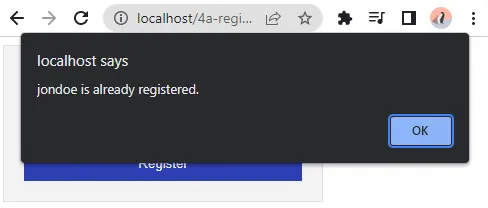Welcome to a tutorial on how to check for user availability in PHP and MySQL. So, you are creating your own registration page, and need to check if a username is already taken? There are quite a few things to look out for – Read on for a detailed example!
TABLE OF CONTENTS
DOWNLOAD & NOTES
Here is the download link to the example code, so you don’t have to copy-paste everything.
EXAMPLE CODE DOWNLOAD
Just click on “download zip” or do a git clone. I have released it under the MIT license, so feel free to build on top of it or use it in your own project.
SORRY FOR THE ADS...
But someone has to pay the bills, and sponsors are paying for it. I insist on not turning Code Boxx into a "paid scripts" business, and I don't "block people with Adblock". Every little bit of support helps.
Buy Me A Coffee Code Boxx eBooks
CHECK USERNAME AVAILABILITY
All right, let us now get into the example of checking for the username availability in PHP and MYSQL.

PART 1) THE DATABASE
CREATE TABLE `users` (
`user_id` bigint(20) NOT NULL,
`user_name` varchar(255) CHARACTER SET utf8mb4 COLLATE utf8mb4_bin NOT NULL
) ENGINE=InnoDB DEFAULT CHARSET=utf8mb4;
INSERT INTO `users` (`user_id`, `user_name`) VALUES
(1, 'joedoe'),
(2, 'johdoe'),
(3, 'joidoe'),
(4, 'jondoe'),
(5, 'joydoe');
ALTER TABLE `users`
ADD PRIMARY KEY (`user_id`),
ADD UNIQUE KEY `user_name` (`user_name`);
ALTER TABLE `users`
MODIFY `user_id` bigint(20) NOT NULL AUTO_INCREMENT, AUTO_INCREMENT=6;First, let us start with the database. This over-simplified example only has the primary key user_id, and a user_name column… Add more fields as required in your own project. A few things to take note though:
ADD UNIQUE KEY `user_name`The user name is set to unique to prevent duplicates.utf8mb4_binThe user name is case-sensitive. That is,jondoeis different fromJonDoe. If you prefer case-insensitive, just use the “normal”utf8mb4-general-ci.
PART 2) PHP USER LIBRARY
<?php
class Users {
// (A) CONSTRUCTOR - CONNECT TO DATABASE
private $pdo = null;
private $stmt = null;
public $error = null;
function __construct () {
$this->pdo = new PDO(
"mysql:host=".DB_HOST.";dbname=".DB_NAME.";charset=".DB_CHARSET,
DB_USER, DB_PASSWORD, [
PDO::ATTR_ERRMODE => PDO::ERRMODE_EXCEPTION,
PDO::ATTR_DEFAULT_FETCH_MODE => PDO::FETCH_ASSOC
]);
}
// (B) DESTRUCTOR - CLOSE DATABASE CONNECTION
function __destruct () {
if ($this->stmt !== null) { $this->stmt = null; }
if ($this->pdo !== null) { $this->pdo = null; }
}
// (C) HELPER FUNCTION - RUN SQL QUERY
function query ($sql, $data=null) : void {
$this->stmt = $this->pdo->prepare($sql);
$this->stmt->execute($data);
}
// (D) GET USER BY USERNAME
function getByName ($name) {
$this->query("SELECT * FROM `users` WHERE `user_name`=?", [$name]);
return $this->stmt->fetch();
}
// (E) ADD NEW USER
function add ($name) {
// (E1) VALID USER NAME
if (preg_match("/\s/", $name)) {
$this->error = "User name cannot contain spaces.";
return false;
}
// (E2) ALREADY REGISTERED
$user = $this->getByName($name);
if (is_array($user)) {
$this->error = "$name is already registered.";
return false;
}
// (E3) INSERT
$this->query("INSERT INTO `users` (`user_name`) VALUES (?)", [$name]);
return true;
}
}
// (F) DATABASE SETTINGS - CHANGE TO YOUR OWN!
define("DB_HOST", "localhost");
define("DB_NAME", "test");
define("DB_CHARSET", "utf8mb4");
define("DB_USER", "root");
define("DB_PASSWORD", "");
// (G) NEW USERS OBJECT
$_USR = new Users();With the database in place, we can now work on the library. This looks massive at first, but keep calm and look carefully – These are quite literally “SQL-related functions” only.
- (A, B, G) When
$_USR = new Users()is created, the constructor will automatically connect to the database. The destructor closes the connection. - (C)
query()A helper function to run a SQL query. - (D)
getByName()Get the user with the given user name. - (E)
add()Register a new user, but check for a valid user name first. Yes, modify this to your own needs – Add more of your own checks, register more fields, or even send out an email. - (F) Change the database settings to your own.
PART 3) REGISTRATION AJAX HANDLER
<?php
if (isset($_POST["req"])) {
require "2-users-lib.php";
switch ($_POST["req"]) {
case "add":
echo $_USR->add($_POST["name"]) ? "OK" : $_USR->error;
break;
}}With the foundations in place, we will deal with the actual processing next.
- Just send
$_POST["req"]to this script to specify the request. Right now, this simple script only has anaddendpoint. - That is, send
$_POST["req"] = "add"and$_POST["name"] = "USERNAME"to process “add new user”.
Feel free to add more endpoints and services as required.
PART 4) REGISTRATION PAGE
4A) THE HTML
<form id="register" onsubmit="return register()">
<label>User Name</label>
<input type="text" name="name" required>
<input type="submit" value="Register">
</form>Lastly, the registration page itself. Nothing “special” here, just the usual HTML form.
4B) THE JAVASCRIPT
function register () {
// (A) FORM DATA
var data = new FormData(document.getElementById("register"));
data.append("req", "add");
// (B) AJAX FETCH
fetch("3-users-ajax.php", { method:"POST", body:data })
.then(res => res.text())
.then(txt => {
// (B1) ADD OK - REDIRECT TO WELCOME PAGE? RELOAD?
if (txt == "OK") {
alert("OK");
// location.href = "welcome.html";
}
// (B2) NOT OK
else { alert(txt); }
})
.catch(err => console.error(err));
// (C) PREVENT FORM SUBMIT
return false;
}Yep, we get the HTML form here, and POST it to the above 3-users-ajax.php for processing. The end.
EXTRAS
That’s all for the tutorial, and here is a small section on some extras and links that may be useful to you.
CHECK USERNAME AVAILABILITY WITHOUT SUBMITTING THE FORM
- Add a new
case "check"in3-users-ajax.php–echo is_array($_USR->getByName($_POST["name"])) ? "TAKEN" : "NOT". - Change the HTML form
4a-register.html–<input type="text" onchange="check()">. - Add a new
check()function in4b-register.js. Pretty much a clone ofregister().
But personally, this does not make sense… You have to double-check the user name on submission anyway.
COMPATIBILITY CHECKS
- Arrow Functions – CanIUse
- Fetch – CanIUse
Will work generally well across all modern browsers.
LINKS & REFERENCES
- Simple User Registration With PHP MYSQL – Code Boxx
THE END
Thank you for reading, and we have come to the end. I hope that it has helped you to better understand, and if you want to share anything with this guide, please feel free to comment below. Good luck and happy coding!
